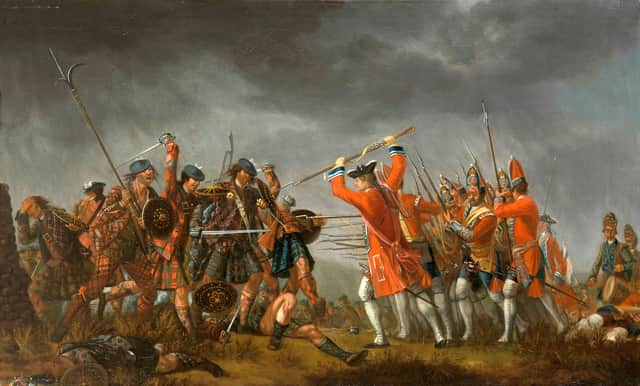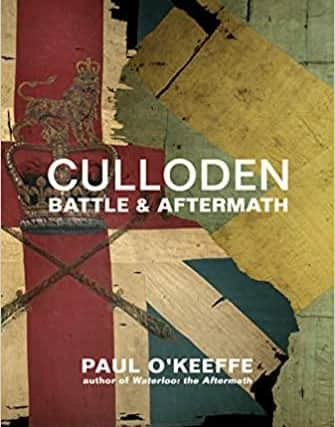Book review: Culloden, Battle & Aftermath, by Paul O'Keefe


Prestonpans, Falkirk and Culloden, the three pitched battles of the ’45, were brief affairs, lasting in total not much longer than the 90 minutes of a football match. The last, Culloden, was decisive. It ended all hope, even the faintest, of a Stuart Restoration. What followed destroyed the traditional clan society of the Highlands. It was the last pitched battle in Scotland, but it wasn’t as some obstinately suppose, a battle between Scotland and England. There was indeed more Scottish than English support for the Jacobites, but there was also more Scottish support for the established Hanoverians than for the Stuarts.
Culloden made George II’s son, the Duke of Cumberland, the hero of Lowland Scotland. Edinburgh and Glasgow both celebrated news of his victory at Culloden with relief and enthusiasm. It was some time before the brutality of the “pacification” of the Highlands saw him named the “Butcher” rather than “Conquering Hero” as in Handel’s Oratorio composed to honour him. Cumberland was certainly harsh, dismissing the advice offered by the Lord President, Duncan Forbes, that clemency was better policy than severity as worthy only of an old woman. On his own terms Cumberland was successful; neither Jacobites nor the Highlands troubled the British State again.
Advertisement
Hide AdIf you are looking for the romance of the ’45 and the ever-thrilling story of the Flight through the Heather, this work of deep and diligent research isn’t the book for you. Nor does Paul O’Keefe spend time pondering the might-have-beens of history as so many of us who have written about the ‘45 have. So he has no time to speculate on how things might have turned out if the Prince and not Lord George Murray had prevailed at that fateful conference at Derby.


Yet this is a fascinating book. O’Keefe describes the battles succinctly; more to the point he is interested in the technology of war, discussing for instance, the importance of the British Army’s adoption of the ring-bayonet. There is no romance either in his account of fighting; wounds are horrible and the dead are stripped of their possessions, their bodies humiliated.
The ’45 Rising briefly unnerved the Government and the revenge it took was a measure of how badly it had been shaken. That revenge was not restricted to the pacification of the Highlands. Prisoners were tried for treason, some subjected to the full horror of the prescribed death for that offence, others lucky only to be hanged. Many were transported to the West Indian and American colonies as indentured labourers, a punishment distinct from slavery only in not being necessarily a life sentence. Other Jacobites would choose emigration. Some, among them Flora Macdonald’s husband, would, ironical as it may seem, fight on the loyalist (Tory) side against the next generation of rebels, the American colonists. Conversely the Presbyterian minister John Witherspoon, briefly imprisoned by the Jacobites after the Battle of Falkirk, would, after emigrating to America, become a rebel and one of the Signers of the Declaration of Independence.
O’Keefe is concerned with much more than the military campaign of 1745-6, though he recounts this with authority and in great detail, drawing on numerous accounts by participants and observers. He pays more attention than most who have written about the Rising to the immediate responses of contemporaries: to the panic in London, which sparked wild rumours and a run on the Bank of England, before giving way to first relief, then rejoicing and the lust for revenge. This supplements his meticulous narrative of the pacification of the Highlands and the building of roads and forts which followed the victory at Culloden.
In short, he gives us a fascinating portrait of 18th century Britain as an age of elegance and brutality. What he can’t give is an explanation of why so many rallied to the Jacobite Cause even while, in so many cases, recognizing how slim and unlikely was the chance of success. Not for the first time I have found myself brooding on the 300 men of the Manchester Regiment who remained loyal to the cause to the bitter end and suffered accordingly. I recommend this book strongly. Nobody who reads it will be content again with the Romance of the ’45. Moreover, no reader will ever again suppose that the Jacobites represented the popular cause in Scotland. For Lowland Scotland, for the citizens of Edinburgh and Glasgow, the Rising was a deplorable and briefly terrifying Rebellion.
Paul O’Keefe: Culloden, Battle & Aftermath, The Bodley Head, 373pp. £25
A message from the Editor:
Advertisement
Hide AdThank you for reading this article. We're more reliant on your support than ever as the shift in consumer habits brought about by coronavirus impacts our advertisers.
If you haven't already, please consider supporting our trusted, fact-checked journalism by taking out a digital subscription at https://www.scotsman.com/subscriptions
Joy Yates, Editorial Director